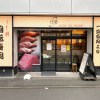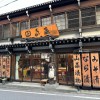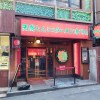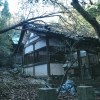Living in Japan, it’s easy to take safety and honesty for granted. This is, after all, the country where public trains make ideal spots for a nap.
That said, with over 150 million people in the country, you’re bound to have a few bad apples, such as the lowlifes who’ve decided there’s no better place for a crime spree than the town of Yamamoto, which was hit hard by the massive earthquake and tsunami of 2011.
Homes throughout Yamamoto, located in Miyagi Prefecture, were destroyed by the quake and following flooding. Many residents have made the painful choice of relocating rather than rebuilding, and the city’s population of 13,269 is more than 3,000 less than it was in 2010, before the disaster struck. With so few residents remaining, at night the streets are practically deserted.
Unfortunately, some thieves have seized the opportunity presented by this lack of watching eyes to enact a string of robberies. The most recent, as well as despicable, occurred at the former location of Yamamoto’s Higashi Day Care Center.
The building itself was washed away by the tsunami, which claimed the lives of three children inside at the time. In their memory, a local volunteer group placed a number of offerings at the site, including prayer sticks and jizo. Jizo are statues of deities often placed along roads to watch over travelers, but they also serve as guardians of the souls of children who pass away at a young age, as well as fetuses not carried to term.
The jizo at the Higashi Day Care Center were produced by monks from the city of Aizuwakamatsu, a town of historical and cultural significance in Fukushima Prefecture, a region which also saw extensive damage in the 2013 earthquake. Five jizo were made, three of which were 20 centimeters (7.9 inches) tall, and two measuring 15 centimeters, with the size differential representing the bond between the children and their parents. The porcelain statues, along with the prayer sticks and three alters with flowers, were placed at the site of the day care center on August 23.
▼ Prayer sticks
▼ Jizo
Several days later, to the volunteers’ shock, the alters, seven prayer sticks, and three large jizo had all been made off with, along with another prayer stick the group had tied to a nearby bridge. “I never imagined someone would steal offerings for children who lost their lives,” said Hitomi Kano, the appalled representative director of the organization. The volunteers filed a report with police in the nearby precinct of Watari on September 3.
Sadly, this was not an isolated incident in Yamamoto, where a similar theft occurred at Fumonji Temple, located in the town’s mountains. Damage from the tsunami at Fumonji was so extensive that several graves were overturned, spilling the ashes interred within them. These were gathered and shaped into a burial mound, atop which was placed a statue of Kannon, the Buddhist goddess of mercy. In May, the 30-kilogram (66-pound) statue was stolen, with tracks in the earth showing it had been dragged away. Eight days after the theft was announced to the public, the statue was anonymously returned to its original location.
▼ Fumonji’s statue of Kannon
More secular robberies have taken place at a roadside construction site along a highway in Yamamoto, which thieves hit twice last month, carrying away a total of 149 sheets of steel. “We suspect they will try to sell them as scrap metal,” said a spokesperson from the prefectural Public Works Bureau.
The Watari Police Precinct is continuing its investigation into the thefts, and stresses that citizens should be extra cautious with their property and report any suspicious activity to the authorities. In the interest of preventing further crimes, 160 light installations have been placed in Yamamoto, primarily in the areas that sustained the greatest flood damage.
“We haven’t seen anything like this in Watari,” said the lead investigator on the case, “so we don’t know why this continues to happen in Yamamoto. We don’t understand why this keeps happening, other than that some people want to cause additional grief for the victims and survivors of the disaster.”
We don’t have any theories about the motive behind these crimes either, but we have no shortage of ideas about what we’d like done to the people responsible.
Source: Kahoku

 Police baffled by bizarre guard rail crime theft crime spree in Japan
Police baffled by bizarre guard rail crime theft crime spree in Japan Japan’s Raincoat Man arrested for stealing 360 women’s raincoats, “As exciting as lingerie”【Vids】
Japan’s Raincoat Man arrested for stealing 360 women’s raincoats, “As exciting as lingerie”【Vids】 Japan Travel: Mysterious rockstar Jizo statue found at Kiyomizudera temple
Japan Travel: Mysterious rockstar Jizo statue found at Kiyomizudera temple Japanese man arrested for stealing women’s shoes and replacing them with new ones
Japanese man arrested for stealing women’s shoes and replacing them with new ones We go looking for the free kaoyu hot spring facebath of onsen town Kusatsu【Photos】
We go looking for the free kaoyu hot spring facebath of onsen town Kusatsu【Photos】 Studio Ghibli releases new mug and tumbler collection featuring Jiji and Totoro
Studio Ghibli releases new mug and tumbler collection featuring Jiji and Totoro “Mt. Fuji convenience store” issues apology for bad tourist manners, adds multilingual signs
“Mt. Fuji convenience store” issues apology for bad tourist manners, adds multilingual signs A guide to riding the Shinkansen bullet train with a terrible-twos kid
A guide to riding the Shinkansen bullet train with a terrible-twos kid The best kebab in Tokyo? We find out if Moses in Shibuya lives up to the hype
The best kebab in Tokyo? We find out if Moses in Shibuya lives up to the hype Tokyo tortilla restaurant is worth visiting whether you love or hate traditional Mexican cuisine
Tokyo tortilla restaurant is worth visiting whether you love or hate traditional Mexican cuisine Starbucks Japan sells a paper tote bag that looks like a free bag…so should you buy it?
Starbucks Japan sells a paper tote bag that looks like a free bag…so should you buy it? Is the absolute closest conveyor belt sushi to Akihabara Station any good? Let’s find out!
Is the absolute closest conveyor belt sushi to Akihabara Station any good? Let’s find out! This is Japan’s, and the world’s, first capsule hotel, and you can still stay there
This is Japan’s, and the world’s, first capsule hotel, and you can still stay there Enjoy the hydrangeas, birds, and more at Fuji Kachoen Garden Park in Shizuoka Prefecture
Enjoy the hydrangeas, birds, and more at Fuji Kachoen Garden Park in Shizuoka Prefecture Cheap Japanese ryokan at Kusatsu Onsen is hidden at the back of a traditional store
Cheap Japanese ryokan at Kusatsu Onsen is hidden at the back of a traditional store McDonald’s Japan’s new pancake pie is a taste sensation
McDonald’s Japan’s new pancake pie is a taste sensation Bad tourist manners at Mt Fuji Lawson photo spot prompts Japanese town to block view with screens
Bad tourist manners at Mt Fuji Lawson photo spot prompts Japanese town to block view with screens FUK COFFEE?!? Japanese cafe has a perfectly innocent reason for its startling-looking name
FUK COFFEE?!? Japanese cafe has a perfectly innocent reason for its startling-looking name Studio Ghibli unveils new goods that tip the hat to The Cat Returns
Studio Ghibli unveils new goods that tip the hat to The Cat Returns How to make a secret rice bowl at Ichiran ramen
How to make a secret rice bowl at Ichiran ramen One of Japan’s oldest castles now lets travelers spend night on the grounds, drink in its keep
One of Japan’s oldest castles now lets travelers spend night on the grounds, drink in its keep Foreigner’s request for help in Tokyo makes us sad for the state of society
Foreigner’s request for help in Tokyo makes us sad for the state of society Two things to do, and two things not to do, when leaving a traditional Japanese inn
Two things to do, and two things not to do, when leaving a traditional Japanese inn Japan has nearly 4 million abandoned homes, but where and why?
Japan has nearly 4 million abandoned homes, but where and why? McDonald’s new Happy Meals offer up cute and practical Sanrio lifestyle goods
McDonald’s new Happy Meals offer up cute and practical Sanrio lifestyle goods Our Japanese reporter visits Costco in the U.S., finds super American and very Japanese things
Our Japanese reporter visits Costco in the U.S., finds super American and very Japanese things Japanese ramen restaurants under pressure from new yen banknotes
Japanese ramen restaurants under pressure from new yen banknotes All-you-can-drink Starbucks and amazing views part of Tokyo’s new 170 meter-high sky lounge
All-you-can-drink Starbucks and amazing views part of Tokyo’s new 170 meter-high sky lounge More foreign tourists than ever before in history visited Japan last month
More foreign tourists than ever before in history visited Japan last month Disney princesses get official manga makeovers for Manga Princess Cafe opening in Tokyo
Disney princesses get official manga makeovers for Manga Princess Cafe opening in Tokyo French Fries Bread in Tokyo’s Shibuya becomes a hit on social media
French Fries Bread in Tokyo’s Shibuya becomes a hit on social media Sales of Japan’s most convenient train ticket/shopping payment cards suspended indefinitely
Sales of Japan’s most convenient train ticket/shopping payment cards suspended indefinitely Sold-out Studio Ghibli desktop humidifiers are back so Totoro can help you through the dry season
Sold-out Studio Ghibli desktop humidifiers are back so Totoro can help you through the dry season Japanese government to make first change to romanization spelling rules since the 1950s
Japanese government to make first change to romanization spelling rules since the 1950s Ghibli founders Toshio Suzuki and Hayao Miyazaki contribute to Japanese whisky Totoro label design
Ghibli founders Toshio Suzuki and Hayao Miyazaki contribute to Japanese whisky Totoro label design Tokyo’s most famous Starbucks is closed
Tokyo’s most famous Starbucks is closed Doraemon found buried at sea as scene from 1993 anime becomes real life【Photos】
Doraemon found buried at sea as scene from 1993 anime becomes real life【Photos】 One Piece characters’ nationalities revealed, but fans have mixed opinions
One Piece characters’ nationalities revealed, but fans have mixed opinions We asked a Uniqlo employee what four things we should buy and their suggestions didn’t disappoint
We asked a Uniqlo employee what four things we should buy and their suggestions didn’t disappoint 15 tons of sweet potatoes stolen in rural Japan, criminal crew may be targeting spuds
15 tons of sweet potatoes stolen in rural Japan, criminal crew may be targeting spuds Most Japanese theft ever? Chainsaws taken to flowering cherry blossoms in Osaka
Most Japanese theft ever? Chainsaws taken to flowering cherry blossoms in Osaka People in Japan are now stealing toilet paper in midst of coronavirus crisis
People in Japan are now stealing toilet paper in midst of coronavirus crisis Three Japanese man in their 80s arrested on suspicion of being a ring of thieves
Three Japanese man in their 80s arrested on suspicion of being a ring of thieves Why do people spend so long in jail without going to trial in Japan?
Why do people spend so long in jail without going to trial in Japan? Japan surprised to find Justin Bieber and world praying for them
Japan surprised to find Justin Bieber and world praying for them Two members of the Goat Weeding Corps believed to have been abducted in Gifu while on duty
Two members of the Goat Weeding Corps believed to have been abducted in Gifu while on duty What do Chicago hot dogs, a Japanese admiral, and a gold tooth have in common?
What do Chicago hot dogs, a Japanese admiral, and a gold tooth have in common? Japanese police investigate report of foreigner spreading white powder on street in Hyogo
Japanese police investigate report of foreigner spreading white powder on street in Hyogo We visit a tsunami-ravaged region almost a decade after the Great East Japan Earthquake
We visit a tsunami-ravaged region almost a decade after the Great East Japan Earthquake Kyoto police set up system to predict when and where crimes will happen
Kyoto police set up system to predict when and where crimes will happen We visit one of Japan’s stunning secret destinations: the “Road to Laputa” in Kumamoto
We visit one of Japan’s stunning secret destinations: the “Road to Laputa” in Kumamoto Aichi police on lookout for scoundrel who stole public toilet’s flushing handle
Aichi police on lookout for scoundrel who stole public toilet’s flushing handle Elderly pickpocket “Calling Tamako” finally apprehended after string of Tokyo thefts
Elderly pickpocket “Calling Tamako” finally apprehended after string of Tokyo thefts Japan’s new traffic cones come with built-in Jizō Bosatsu, the protective deity of travellers
Japan’s new traffic cones come with built-in Jizō Bosatsu, the protective deity of travellers
Leave a Reply